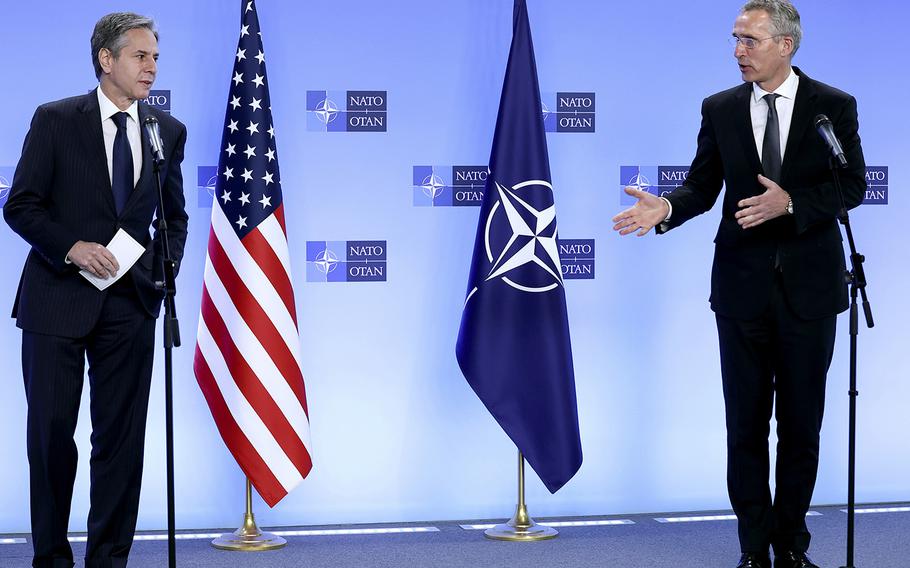
NATO Secretary General Jens Stoltenberg, right, and United States Secretary of State Antony Blinken address a media conference at NATO headquarters in Brussels, Wednesday, April 14, 2021. (Kenzo Tribouillard, pool/via AP)
STUTTGART, Germany — The NATO alliance, which rushed to join the United States in Afghanistan in the aftermath of the 9/11 terrorist attacks, will depart the war-torn country alongside American forces in the months ahead, allies announced Wednesday.
“Standing shoulder to shoulder, we have paid a high price, both in blood and treasure,” NATO Secretary-General Jens Stoltenberg said from NATO headquarters in Brussels, where he was flanked by Defense Secretary Lloyd Austin and Secretary of State Antony Blinken.
The NATO drawdown of its 10,000 troops will begin by May 1 and will be “orderly, coordinated and deliberate.” The drawdown also will be completed within a few months, Stoltenberg said.
“This is not an easy decision, and it entails risks,” the NATO chief said.
However, after two decades, he said it’s become clear there is no Western-led military solution to the challenges Afghanistan faces.
“We will leave Afghanistan together and bring our troops home,” Blinken said. “After years of saying we will leave at some point, that time has come.”
Blinken also said the original purpose of the war, eliminating the threat to the U.S. homeland posed by al-Qaida in Afghanistan, has been achieved.
The war, which killed and maimed thousands of U.S. troops, ultimately reduced the ability of militants to launch attacks on the United States, Austin concurred.
“Our troops have accomplished the mission they were sent to Afghanistan to accomplish,” he said.
Allies will respond forcefully, Austin said, if the Taliban launches attacks on coalition forces as they draw down.
NATO’s decision, reached during a high-level meeting at alliance headquarters, was almost inevitable following an announcement Wednesday by President Joe Biden that the U.S. will pull all of its troops out of Afghanistan before the 20th anniversary of the 9/11 attacks, which sparked the longest American war in history.
The Afghanistan war marked the first time in history that NATO allies invoked Article V, an alliance bedrock principle that an attack on one member is met with a response from all. For nearly 20 years, U.S. commanders and political leaders have said the end of the war in Afghanistan would be conditions based. But in announcing an end to U.S. military involvement, Biden said the time has come to pull out regardless of security conditions on the ground.
The withdrawal of roughly 2,500 U.S. troops in Afghanistan and thousands more NATO forces will be wrapped up before September.
The decision to depart is not without risk given the weakness of the Afghan government and doubts about the Afghan military’s ability to hold off the Taliban without international military backing. Blinken acknowledged even with U.S. military backing, Afghan forces remain locked in a stalemate.
Austin said the U.S. will continue to lend financial support to Afghanistan and its security forces.
The U.S. is expected to reposition counterterrorism forces in the region to be able to respond to threats should they emerge in Afghanistan. Austin declined to say what possible locations could be for such a force.
In 2014, NATO ended its formal combat role in Afghanistan as it shifted to training and advisory mission. But that didn’t spell the end to the fighting, though most of the combat was left to U.S. forces in subsequent years.
During that time, Afghan forces were officially in the lead on the battlefield but received massive logistics and advisory support from the U.S.-led coalition. The Afghan military has taken heavy casualties over the years at the hands of Taliban insurgents, who often seized the initiative despite lacking the superior armaments and air power provided by Western forces.
At its peak, the NATO-led combat force in Afghanistan peaked at 140,000 troops in about 2010, but by 2014 that number had dropped down to 13,000 troops as allies transitioned to its training effort. The numbers gradually declined with the passing years.
In all, more about 3,500 coalition troops — mostly American — were killed in the nearly 20-year campaign and more than 30,000 were injured. The U.S. also spent hundreds of billions of dollars on the war that started as a mission to eliminate al-Qaida fighters after the 9/11 attacks, but then morphed into a sprawling nation-building campaign that critics of the war said ultimately proved to be wasteful.
vandiver.john@stripes.com Twitter: @john_vandiver